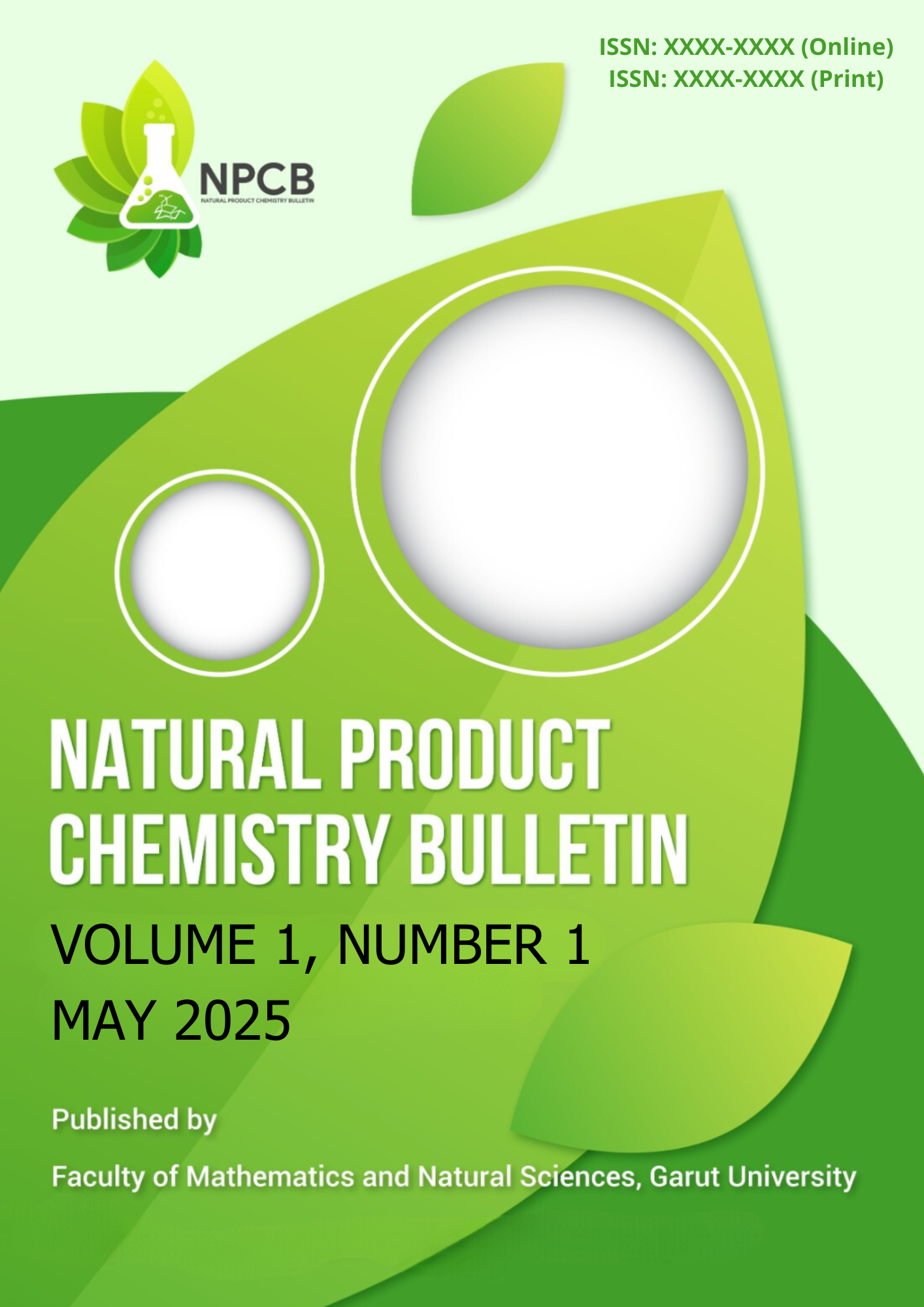Mini Review: Fitokimia, Kemotaksonomi, Dan Sifat Biologis Metabolit Sekunder Dari Tanaman Manggis (Garcinia mangostana L.)
DOI:
https://doi.org/10.52434/npcb.v1i1.42540Keywords:
Garcinia mangostana L, kemotaksonomi, sifat biologis, sitotoksik, tanaman Manggis xanthoneAbstract
Artikel ini membahas aspek fitokimia, kematoksonomi, dan sifat biologis dari senyawa-senyawa yang diisiolasi dari Tanaman Manggis (Garcinia mangostana L.). Dari kajian fitokimia, terdapat 86 senyawa metabolit sekunder telah berhasil diisolasi dan diidentifikasi, yang meliputi xanthone, flavanoid, triterpenoid, benzofenon, bifenil, pirol, dan benzofuran. Kajian kematoksonomi memperlihatkan bahwa senyawa-senyawa pada Tanaman Manggis (Garcinia mangostana L.) juga ditemukan pada tanaman dengan satu famili, yaitu Garcinia. Senyawa yang ditemukan telah dievaluasi aktivitas biologisnya melalui berbagai sistem uji, meliputi sifat sitotoksik, antibakteri dan antijamur, antioksidan, antimalaria, topoisomerasi I dan II, antiinflamasi, HIV-1 protease dan reverse transkriptase. Hasil pengujian senyawa-senyawa metabolit sekunder Manggis memiliki potensi besar sebagai agen antikanker, antioksidan, antibakteri dan antijamur. Pengembangan masih terus dilakukan untuk memperjelas hasil kajian dalam analisis manfaat Tanaman Manggis (Garcinia mangostana L.) sebagai sumber bahan kimia yang memiliki banyak manfaat.
References
Alekshun, M. N., & Levy, S. B. (2006). Commensals upon us. Biochemical Pharmacology, 71(7), 893–900. https://doi.org/10.1016/j.bcp.2005.12.040
Amin, S., Aryanti, R., & Aprilia, A. Y. (2023). Studi In Silico Senyawa yang Terkandung dalam Kulit Buah Manggis (Garcinia mangostana L.) Sebagai Antikanker Payudara. Prosiding Seminar Nasional Diseminasi Penelitian, 3. https://ejurnal.universitas-bth.ac.id/index.php/PSNDPV3/article/view/1162
Anantachoke, N., Tuchinda, P., Kuhakarn, C., Pohmakotr, M., & Reutrakul, V. (2012). Prenylated caged xanthones: Chemistry and biology. Pharmaceutical Biology, 50(1), 78–91. https://doi.org/10.3109/13880209.2011.636176
Azebaze, A. G. B., Meyer, M., Valentin, A., Nguemfo, E. L., Fomum, Z. T., & Nkengfack, A. E. (2006). Prenylated Xanthone Derivatives with Antiplasmodial Activity from Allanblackia monticola Staner L.C. Chemical and Pharmaceutical Bulletin, 54(1), 111–113. https://doi.org/10.1248/cpb.54.111
Chen, S. X., Wan, M., & Loh, B. N. (1996). Active Constituents against HIV-1 Protease from Garcinia mangostana. Planta Medica, 62(4), 381–382. https://doi.org/10.1055/s-2006-957916
Chin, Y. W., Jung, H. A., Chai, H., Keller, W. J., & Kinghorn, A. D. (2008). Xanthones with Quinone Reductase-Inducing Activity from the Fruits of Garcinia mangostana (Mangosteen). Phytochemistry, 69(3), 754–758. https://doi.org/10.1016/j.phytochem.2007.09.023
Cui, J., Hu, W., Cai, Z., Liu, Y., Li, S., Tao, W., & Xiang, H. (2010). New Medicinal Properties of mangostins: Analgesic Activity and Pharmacological Characterization of Active Ingredients from the Fruit Hull of Garcinia mangostana L. Pharmacology Biochemistry and Behavior, 95(2), 166–172. https://doi.org/10.1016/j.pbb.2009.12.021
Farnsworth, N. R., & Bunyapraphatsara, N. (1992). Thai Medicinal Plants Recommended for Primary Health Care System. Mahidol University.
Gopalakrishnan, G., Banumathi, B., & Suresh, G. (1997). Evaluation of the Antifungal Activity of Natural Xanthones from Garcinia mangostana and Their Synthetic Serivatives. Journal of Natural Products, 60(5), 519–524. https://doi.org/10.1021/np970165u
Gutierrez-Orozco, F., & Failla, M. L. (2013). Biological Activities and Bioavailability of mangosteen xanthones: A Critical Review of the Current Evidence. Nutrients, 5(8), 3163–3183. https://doi.org/10.3390/nu5083163
Heyne, K. (1987). Tumbuhan berguna Indonesia III. In Yayasan Sarana Wana Jaya Jakarta. Yayasan Sarana Wana Jaya Jakarta.
Himawan, H. C., Sulastri, L., & Vernando, V. (2018). Penambatan Molekuler Senyawa Xanton pada Kulit Buah Manggis (Garcinia Mangostana L.) dengan Enzim Cox-2 sebagai Kandidat Antikanker Payudara. Jurnal Farmamedika (Pharmamedica Journal), 3(1), 34–42. https://doi.org/10.47219/ath.v3i1.28
Iinuma, M., Tosa, H., Tanaka, T., Asai, F., Kobayashi, Y., Shimano, R., & Miyauchi, K. I. (1996). Antibacterial Activity of Xanthones from Guttiferaeous Plants against methicillin-resistant Staphylococcus aureus. Journal of Pharmacy and Pharmacology, 48(8), 861–865. https://doi.org/10.1111/j.2042-7158.1996.tb03988.x
Jung, H. A., Su, B. N., Keller, W. J., Mehta, R. G., & Kinghorn, A. D. (2006). Antioxidant Xanthones from the Pericarp of Garcinia mangostana (Mangosteen). Journal of Agricultural and Food Chemistry, 54(6), 2077. https://doi.org/10.1021/jf052649z
Loo, A. E. K., & Huang, D. (2007). Assay-guided Fractionation Study of α-amylase Inhibitors from Garcinia mangostana pericarp. Journal of Agricultural and Food Chemistry, 55(24), 9805-9810. https://doi.org/10.1021/jf071500f
Mahabusarakam, W., Kuaha, K., Wilairat, P., & Taylor, W. C. (2006). Prenylated Xanthones as Potential Antiplasmodial Substances. Planta Medica, 72(10), 912–916. https://doi.org/10.1055/s-2006-947190
Moongkarndi, P., Kosem, N., Kaslungka, S., Luanratana, O., Pongpan, N., & Neungton, N. (2004). Antiproliferation, Antioxidation and Induction of Apoptosis by Garcinia mangostana (mangosteen) on SKBR3 Human Breast Cancer Cell Line. Journal of Ethnopharmacology, 90(1), 90–161. https://doi.org/10.1016/j.jep.2003.09.048
Muhanji, C., & Hunter, R. (2007). Current Developments in the Synthesis and Biological Activity of HIV-1 Double-Drug Inhibitors. Current Medicinal Chemistry, 14(11), 1207–1220. https://doi.org/10.2174/092986707780597952
Mursyidin, D. H., & Maulana, F. N. (2020). Keragaman dan Kekerabatan Genetik Garcinia berdasarkan Kandungan Senyawa Bioaktif dan Aktivitas Biologisnya: Kajian In Silico. Berita Biologi, 19(3A). https://doi.org/10.14203/beritabiologi.v19i3a.3862
Murthy, H. N., Dandin, V. S., Dalawai, D., Park, S. Y., & Paek, K. Y. (2018). Breeding of Garcinia spp. In Advances in Plant Breeding Strategies: Fruits (Vol. 3, pp. 773–809). Springer. https://doi.org/10.1007/978-3-319-91944-7_19
Prasetiawati, R., Permana, B., Soni, D., & Agung, S. N. (2019). Molecular Docking Study of Xanthone Derivative Compounds of Mangosteen Rind (Garcinia mangostana L.) to ER- α ( Estrogen Receptor Alfa) and ER - β ( Estrogen Receptor Beta ) as Anti-Breast Cancer. Jurnal Ilmiah Farmako Bahari, 10(1), 45–52. https://doi.org/https://doi.org/10.52434/jfb.v9i1.642
Putra, S. R. (2011). Manggis Pembasmi Kanker. Diva Press.
Qosim, W. A. (2007). Kulit Buah Manggis Sebagai Antioksidan. Lembaga Pengabdian Masyarakat (LPM) Universitas Padjajaran.
Rahmayanti, F., Suniarti, D. F., Masúd, Z. A., Bachtiar, B. M., Wimardhani, Y. S., & Subita, G. P. (2016). Ethyl Acetate Fraction of garcinia mangostana-linn pericarp extract: Anti - Candida albicans and epithelial cytotoxicity. Asian Journal of Pharmaceutical and Clinical Research, 9(1), 335– 338. https://journals.innovareacademics.in/index.php/ajpcr/article/view/10088
Rassameemasmaung, S., Sirikulsathean, A., Amornchat, C., Hirunrat, K., Rojanapanthu, P., & Gritsanapan, W. (2007). Effects of Herbal Mouthwash Containing the Pericarp Extract of Garcinia mangostana L on Halitosis, Plaque and Papillary Bleeding Index. Journal of the International Academy of Periodontology, 9(1), 19–25. https://pubmed.ncbi.nlm.nih.gov/17274236/
Riscoe, M., Kelly, J. X., & Winter, R. (2005). Xanthones as Antimalarial Agents: Discovery, Mode of Action, and Optimization. Current Medicinal Chemistry, 12(21), 2539–2549. https://doi.org/10.2174/092986705774370709
Ruan, J., Zheng, C., Liu, Y., Qu, L., Yu, H., Han, L., Zhang, Y., & Wang, T. (2017). Chemical and Biological Research on Herbal Medicines Rich in Xanthones. Molecules, 22(10), 1–19. https://doi.org/10.3390/molecules22101698
Sakagami, Y., Iinuma, M., Piyasena, K. G. N. P., & Dharmaratne, H. R. W. (2005). Antibacterial Activity of α-mangostin against Vancomycin Resistant Enterococci (VRE) and Synergism with Antibiotics. Phytomedicine, 12(3), 203–208. https://doi.org/10.1016/j.phymed.2003.09.012
Sampath, P. D., & Vijayaraghavan, K. (2007). Cardioprotective Effect of α-mangostin, a Xanthone Derivative from Mangosteen on Tissue Defense System against Isoproterenol-Induced Myocardial Infarction in Rats. Journal of Biochemical and Molecular Toxicology, 21(6), 336–339. https://doi.org/10.1002/jbt.20199
Shabella, R. (2011). Terapi Kulit Manggis. Galmas.
Sholihah, M., Ahmad, U., & Budiastra, I. W. (2017). Aplikasi Gelombang Ultrasonik Untuk Meningkatkan Rendemen Ekstraksi dan Efektivitas Antioksidan Kulit Manggis. Jurnal Keteknikhan Pertanian, 5(2). https://doi.org/https://doi.org/10.19028/jtep.05.2.%25p
Sinaga, S., Sobir, S., Poerwanto, R., Aswidinnoor, H., & Duryadi, D. (2012). Genetic Diversity and the Relationship Between the Indonesian Mangosteen (Garcinia Mangostana) and the Related Species using Isozyme Markers. Jurnal Natur Indonesia, 13(1), 53–58. https://doi.org/10.31258/jnat.13.1.53-58
Tosa, H., Iinuma, M., Tanaka, T., Nozaki, H., Ikeda, S., Tsutsui, K., Tsutsui, K., Yamada, M., & Fujimori, S. (1997). Inhibitory Activity of Xanthone Derivatives Isolated from Some Guttiferaeous Plants Against DNA Topoisomerases I and II. Chemical and Pharmaceutical Bulletin, 45(2), 418–420. https://doi.org/10.1248/cpb.45.418
Valko, M., Leibfritz, D., Moncol, J., Cronin, M. T. D., Mazur, M., & Telser, J. (2007). Free Radicals and Antioxidants in Normal Physiological Functions and Human Disease. International Journal of Biochemistry and Cell Biology, 39(1), 44–84. https://doi.org/10.1016/j.biocel.2006.07.001
Weecharangsan, W., Opanasopit, P., Ngawhirunpat, T., Rojanarata, T., & Apirakaramwong, A. (2006). Chitosan Lactate as a Nonviral Gene Delivery Vector in COS-1 Cells. AAPS PharmSciTech, 7(3), 74–79. https://doi.org/10.1208/pt070366
Williams, P., Ongsakul, M., Proudfoot, J., Croft, K., & Beilin, L. (1995). Mangostin Inhibits the Oxidative Modification of Human Low Density Lipoprotein. Free Radical Research, 23(2), 175–184. https://doi.org/10.3109/10715769509064030
Yates, P., & Stout, G. H. (1958). The Structure of Mangostin. Journal of the American Chemical Society, 80(7), 1691.
Yoshikawa, M., Harada, E., Miki, A., Tsukamoto, K., Si Qian Liang, Yamahara, J., & Murakami, N. (1994). Antioxidant Constituents from the Fruit Hulls of Mangosteen (Garcinia mangostana L.) Originating in Vietnam. Yakugaku Zasshi, 114(2), 129–133. https://doi.org/10.1248/yakushi1947.114.2_129
Yu, L., Zhao, M., Yang, B., Zhao, Q., & Jiang, Y. (2007). Phenolics from Hull of Garcinia Mangostana Fruit and Their Antioxidant Activities. Food Chemistry, 104(1), 176–181. https://doi.org/10.1016/j.foodchem.2006.11.018
Downloads
Published
Issue
Section
License
or all articles published in Natural Product Chemistry Bulletin, the copyright is retained by the journal. Articles are published under the terms of Creative Commons Attribution-ShareAlike 4.0 International License (CC-BY-SA 4.0) .
For Authors:
- Any article on the copyright is retained by the author(s).
- The author grants the journal, right of first publication with the work simultaneously licensed under a Creative Commons Attribution License that allows others to share work with an acknowledgment of the work authors and initial publications in this journal.
- Authors are able to enter into separate, additional contractual arrangements for the non-exclusive distribution of published articles of work (eg, post-institutional repository) or publish it in a book, with acknowledgment of its initial publication in this journal.
- Authors are permitted and encouraged to post their work online (e.g., in institutional repositories or on their websites) prior to and during the submission process, as can lead to productive exchanges, as well as earlier and greater citation of published work.
- The article and any associated published material is distributed under the Creative Commons Attribution-ShareAlike 4.0 International License


1.png) Download Journal Template
Download Journal Template








